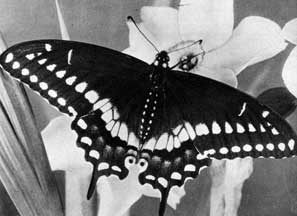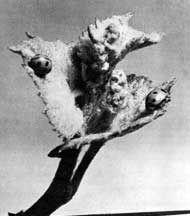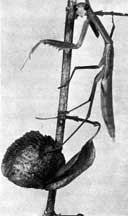By DOROTHY PARKER ROWE
Page 1 [1] | Page 2 | Page 3 [2]
To the credulous, the actions of butterflies often have been matters of great concern. On a summer's day, if a butterfly found its way through an open door into a house, superstitious housewives believed that they soon would have a lady visitor and that she would be wearing a dress of the same color as the insect. Seen in late fall, a butterfly was considered a harbinger of early cold. On the other hand, when a mourning cloak was observed flitting about a woodland glade during a February thaw, the insect was regarded as bringing news of an early spring.
When a summer butterfly settled on the head of a young woman, the fact was accepted as an indication that she would have a new sweetheart. If one of these insects alighted on a person's hand, he was sure to receive unexpected money in the near future. Yellow roadside butterflies clustered about a mud puddle were always skirted carefully by children who had heard the old folklore belief that disturbing such insects was the equivalent of "losing a pot of gold." And who would take such a chance?

IF A BUTTERFLY LIGHTS UPON YOUR SHOULDER YOU WILL RECEIVE A NEW OUTFIT
Those night-flying relatives of the butterflies, the moths, usually have been linked with somber superstitions. In many parts of the world, white moths have been thought to be the returning spirits of departed friends and relatives. In middle Europe, it was said that moths bewitched the butter by flying over the milk-pans or by crawling info the churns. When a moth singed its wings in a candle flame, its misfortune was considered to foretell sickness or dire calamity in the household. Electric lights downed this superstition.

LADYBIRD BEETLES HIBERNATING IN THE HOUSE WERE SUPPOSED TO BE A GOOD OMEN
The children of moths and butterflies also have their place in the realm of these oddity beliefs. When a woolly-bear caterpillar was seen hurrying across an open space, it was taken for granted that winter was close behind. By examining the width of the central band around its body, the gullible believed, the severity of the coming cold could be determined.
Among the English hop-fields, farmers always used to pay dose attention to the chrysalides of certain anglewing butterflies. Golden dots appeared on the sides of these chrysalides. When the dots were large, the hop-growers went about their work confident that the crop would be big and their profits proportionately large. Measuring worms, seen looping along a man's clothing, were often said to be measuring him for a new suit. When they were seen on a woman's hand, they were getting the size for a new pair of gloves. In some regions, the actions of the measuring worms were viewed with foreboding. They were thought to be taking measurements for a shroud.

THE PRAYING MANTIS NATURALLY INSPIRED SUPERSTITIONS
Foreboding has been a frequent attitude toward commonplace actions in the insect world. Leaf miners, those small larvae that eat out curving and looping tunnels within the tissues of leaves were formerly viewed with superstitious dread. The markings they produced were thought to be the signatures of evil spirits. Similarily, the "W" formed by the thickened veins near the tips of the wings of the seventeen-year cicada has been looked upon as a warning of coming "war, want and woe." And, when a swarm of honeybees settled upon a rotten limb, the fearful and credulous people in some of the counties of England accepted it as an indication that there would be a death in the family.
